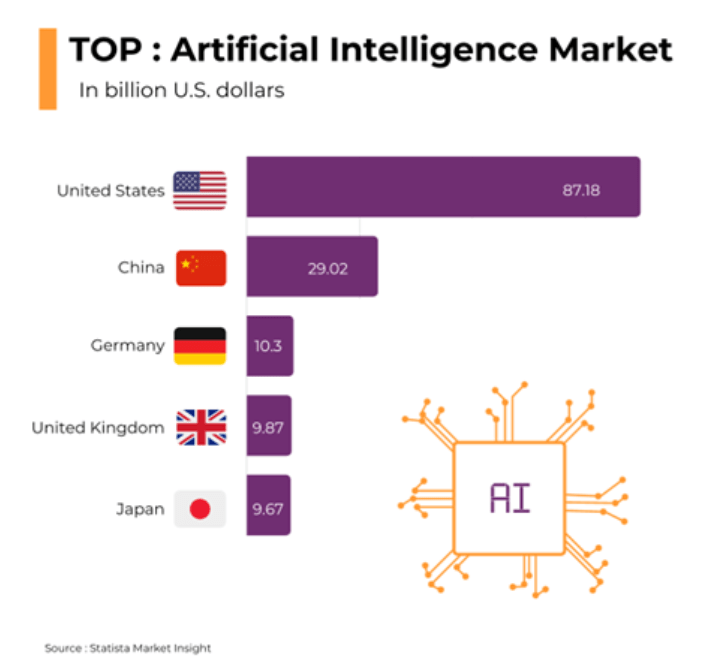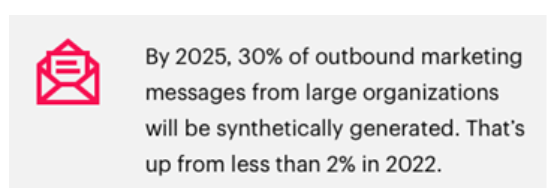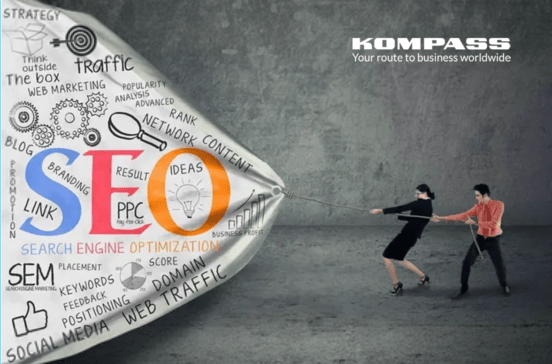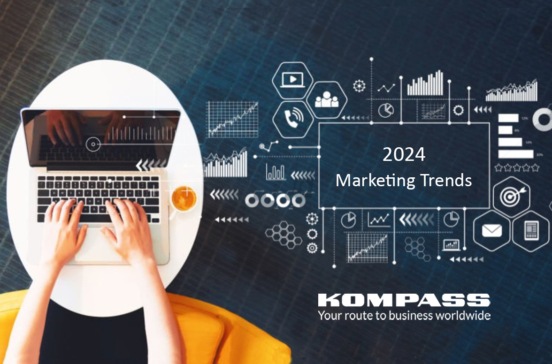In recent months we have seen an increasing interest in the exponential advances being made in generative Artificial Intelligence (AI) technologies. This progress has led to fervent discussions on technology-related risks. AI represents a potentially disruptive inflection point for societies and creates an uncertain environment in which organizations must operate. Even if it may scare off some companies, AI promises significant benefits in key sectors and many organizational functions. AI can help you improve your marketing performance and develop your sales abroad. However, the question arises: how should AI be used in international marketing? Within this article, we’ll give you tips and tools to effectively adapt and promote your products in international markets while leveraging AI.
Artificial Intelligence Market & Trends
AI is defined refers to the ability of a computer or machine to mimic the competencies of the human mind, which often learns from previous experiences to understand and respond to language, decisions, and problems. Statista announced that the market for artificial intelligence (AI) is expected to show strong growth in the coming decade. The AI market size is projected to reach US$241.80bn in 2023. An annual growth rate (CAGR 2023-2030) of 17.30% is expected, resulting in a market volume of US$738.80bn by 2030. For an international comparison, the United States will be the largest market with US$87.18bn in 2023 followed by China, Germany, the UK and Japan.

According to McKinsey & Company; Stanford University, AI is heavily used for corporate finance and service operations and strategy, with 20 percent of companies in nearly all industries reporting usage of AI in these functions. The financial services industry boasts the highest use of AI with over 30 percent of respondents using AI in 2023. The functions and industries showing the lowest use of AI are manufacturing and marketing. This is because these can require individual human instincts and therefore lend themselves less easily to AI applications.
Artificial intelligence (AI) adoption worldwide 2022, by industry and function

AI can hide behind a number of tasks, such as sending emails. According to Gartner Predictions, by 2025, 30% of outbound marketing messages from large organizations will be synthetically generated. That’s up from less than 2% in 2022.

One of the major factors driving the current wave of AI growth is the strong interest of Venture Capital investment in AI start-ups. AI companies have cumulatively raised around US$239.2 billion in funding between 2015-2022. On the technology front, rapid advancements in computing power are driving the industry to the next level. Similarly, open-source platforms are promoting and enabling collaborative learning, which is also conducive to the growth of AI. The current wave of growth in the AI industry is as much about the abundant availability of big data as it is about software and hardware. The amount of big data being generated is growing at a rate of 40% per year and is expected to reach 163 trillion gigabytes by 2025.
AI-enhanced advertising
Two main areas of advertising have been facilitated by the development of AI. First, technology has made ads easier to target and track your target customers. Second, AI can facilitate the creation of content for all your advertising campaigns.
Due to the internet and the advent of programmatic advertising, you now possess the capability to get in touch with consumers across diverse digital platforms. Furthermore, you have the means to tailor advertising by leveraging demographic and behavioral data. Today, you can even conduct experiments with hundreds of distinct advertisements to determine which ones have the most favorable responses.
AI allows you to use data or consumer insights to increase your ad’s relevancy to the intended audience. This can be data related to demographic information, interests, buying intention, or behavioral patterns. But it can be even wider with weather data and location data being taken into consideration, especially when your company is international. AI can help you target your customers in different countries with different cultures and different consumption habits.
Google recently made AI implementation in ads by introducing generative AI tools. The AI-powered campaigns in Google (P-Max) will be generated automatically. The algorithms will simply source your website and marketing materials to generate customized creative headlines that align with specific audiences and campaign objectives. For example, if a customer makes a Google search, AI can use content from your landing page and existing ads to create a new headline that aligns even more closely with the query. This helps you improve ad relevance while staying true to your brand.
AI-Created Marketing Content
Marketing requires a great deal of inspiration and creativity to constantly produce new and compelling content. Sometimes there’s a lack of inspiration, especially if the goal is complex. AI can be used to help you develop new ideas. Whether it’s for your blog, social media, newsletter, or any other content you’re creating. As a concrete example, you can use ChatGPT to suggest Hashtags relevant to the subject you are addressing. You can also use it for promotional campaign name ideas based on the product you want to promote.
Once your idea has been defined, it needs to be implemented. However, you may not have the design skills within your company to create original and technical content. Very often, we leave visual identity aside because we believe that design is superfluous or only responsible for making things “prettier”. However, design is an essential element in creating a dialogue with your target audience, generating recognition and identification with your product. Design is all the more important when you’re expanding internationally. This is because you will need to adapt the design and content of your marketing materials to your targeted country. Certain AI tools can be extremely useful to bridge this gap.
For example, DALL·E 2, developed by Open AI can create original and realistic images from a text description. According to Statista, in 2022, DALL.E 2 was the second most used image generation AI tool after Midjourney, which together accounted for over 50% of image generation using AI tools. With these tools, you can create images and make realistic edits to existing images from a simple caption. It can add and remove elements while taking shadows, reflections, and textures into account. Here are a few examples proposed by OpenAI.
Behavioural International Marketing
Utilizing AI in marketing enables marketers to leverage international customer data to get insights into their purchasing behavior and preferences. It can permit you to put in place dynamic pricing, social media advertising, and automate sales and marketing processes. Depending on the geographical area of the data retrieved, you can adapt your marketing to the country in which you sell. Allowing you to get even closer to your customers’ needs and surpass cultural barriers. To understand these patterns, AI employs techniques such as machine learning.
Many companies have recognized the immense potential of AI for international marketing and have incorporated it into various aspects such as e-commerce, customer support, marketing, and PR. AI has now become an integral component of today’s social media networks. Leading platforms like Facebook, LinkedIn, Instagram, and Snapchat allow marketers to conduct paid advertising campaigns targeting users based on geographics, demographics and behavior. The perfect match to adapt your global marketing.
Starbucks, as a global company, is a great example of AI use. Customers are from all over the world and have different preferences and Starbucks has leveraged AI to make tracking these customers and their preferences easier. According to John Rampton, Starbucks can see when an individual is going to make their next order through its app and uses AI technology to get data. Starbucks’s app records purchases and gets information that includes store location, time, and specific orders. With this precise data, Starbucks’s marketing team can serve more personalized, tailored messages to customers who are likely to purchase at a specific time, from a specific location or a specific product. This messaging includes order recommendations as well as special offers or promotions.
Sephora is another example of the use of AI. Chatbots are commonly used on business websites. They use keyword matching to respond to users’ questions based on a pre-written script and can use AI to provide human-like responses to queries. According to John Rampton, Sephora has used chatbot technology since 2017 to retrieve data on customers, by providing them with specific recommendations. With this information, the company sends out personalized emails and messaging to interested and engaged customers.
Sentiment Analysis
Customer engagement, sentiment and feedback can be key performance indicators if you know how to collect and analyze them. This insight can help you understand your markets abroad better and adapt your strategy, your products and your marketing to the country you are targeting.
Your Marketing department often manages these by crawling the internet in real-time and looking at places like social media platforms and news articles to see mentions of your brand online and trying to gauge general sentiment. AI tools can be used in this instance as they are becoming increasingly effective at monitoring important numbers of sources for keywords. These words can include brand names, competitors, or important phrases that may indicate positive or negative reactions.
For example, a baby clothes company can monitor social media internationally such as LinkedIn, Facebook, Instagram and Twitter for all mentions of their product, company name, and competitors’ names to keep track of how customers abroad are feeling about their sector. With this information, they can adapt their communication, understand international customer needs, and build a better customer experience. To do it you can use tools like OpenText Magellan Test Meaning, a specialized classification that you can use to identify and evaluate subjective patterns and expressions of sentiment within textual content.
Content Translation
AI-powered language translation tools can also be used to localize your marketing content. Localization is a marketing term of adapting your content, product, service to cater to specificities of a country, region, city etc. AI tools employ advanced techniques to efficiently and accurately convert content from a source language into multiple target languages. This facilitates the process for companies looking to access new multilingual markets or connect with their existing user base worldwide. It’s not just Google Translate or DeepL that can translate your texts for you, recent innovations like OpenAI’s generative language model ChatGPT have made translation more accessible than ever.
You can integrate AI-driven localization tools that offer the capability to translate various content types, such as blog posts, support articles, or entire website pages directly into your international strategy. This translation is especially important during the launch of global campaigns. Organizations employing content creators for their marketing content can also leverage AI, as it can be used for tasks like video translation and dubbing, facilitated by specialized AI tools.
According to a 2023 Bain study, nearly 40% of companies are already using generative AI for localization, and predictions show continued growth in this specific use. Recently, Paramount announced that they’re using AI for localization and others will likely follow.
What are some concerns with AI marketing?
Data privacy
To achieve personalization by using AI marketing tools, you need to have a deep understanding of customer data to get personalization right. You have to be able to collect and analyze that data effectively. People are generally open to AI and its role in personalization but data privacy is a primary concern among consumers. Your consumers know that they share their personal information and accept to do it if they trust you. This security and trust can be achieved through implementing robust data security measures, providing clear privacy policies, and allowing customers to control the data collected about them.
Authenticity
A study revealed that 62% of consumers say they’d shop only with authentic brands. But staying authentic while using AI in your marketing strategy is not easy. You should always revise your AI-generated content to guarantee there are no mistakes that might conflict with your brand image.
Cost
Most AI tools come with a substantial price tag. Moreover, the implementation process can take weeks or months. It is therefore difficult to estimate the exact cost and, above all, the return on investment of implementing AI. You can limit the time and expenses linked to AI adoption by, for example, incorporating an AI solution into an existing tool. This strategy can significantly reduce learning time and the implementation process.
Conclusion
The AI marketing industry will continue to grow as the world becomes increasingly digitized, and there are a lot of opportunities for you to take advantage of the technology. AI applications will revolutionize how your company can engage with global consumers and adapt to international markets. In international marketing, businesses that use AI effectively are likely to gain a competitive advantage by reaching global consumers with tailored, data-driven strategies. However, it is crucial to keep in mind that the use of AI in international marketing also presents challenges. Concerns surrounding this topic can be regarding data privacy, authenticity, and the cost of AI tools. Finally, striking the right balance between automation and human touch remains a critical consideration to have success in your global expansion.













Comentarios
No Comments